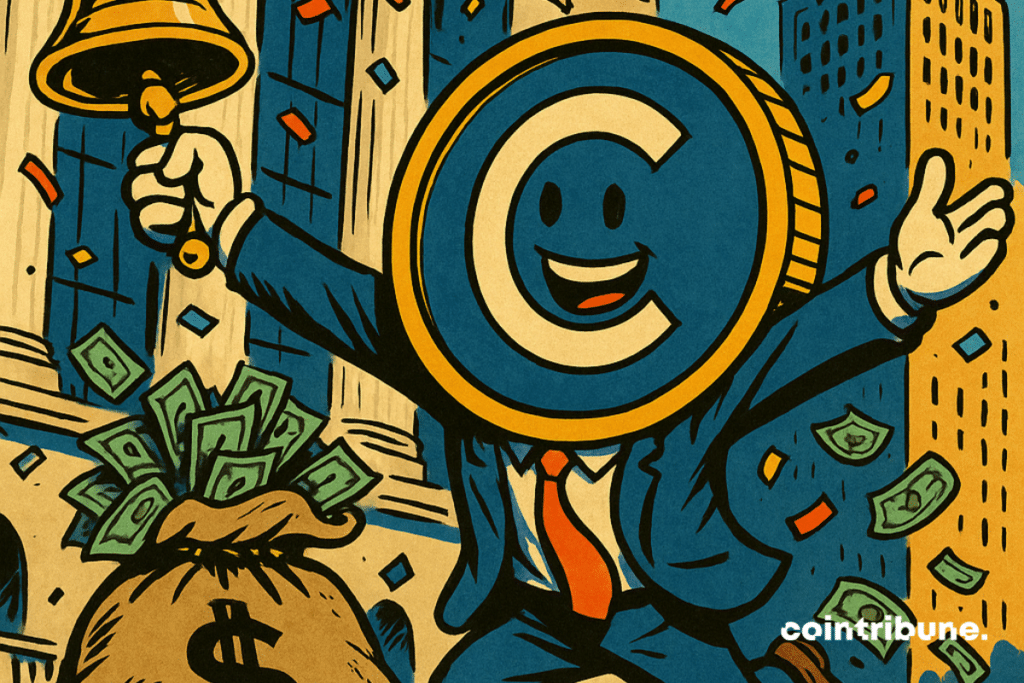Circle's Crazy IPO Hides A $3 Billion Sacrifice
Circle’s IPO made Wall Street history with the biggest two-day surge since 1980. Yet, behind this spectacular performance lies a troubling paradox: the issuer of USDC literally left 3 billion dollars on the table with institutional investors. How can this colossal financial sacrifice be explained?

In brief
- Circle records the strongest two-day IPO performance since 1980, with a +250% surge.
- The stock jumped from $31 to $107.5 in just 48 hours of trading.
- The company left $3 billion “on the table” by undervaluing its IPO.
- This ranks as the 7th largest missed gain in IPO history.
A Stock Market Record That Costs Circle Dearly
Circle orchestrated a true financial tsunami on Thursday, June 5. On the first session, the issuer of the stablecoin USDC soared to 88 dollars, a staggering 180% increase over the subscription price of 31 dollars set by JPMorgan, Goldman Sachs, and Citigroup. This initial performance was only a preview of what awaited investors.
Friday, June 6 confirmed the market’s insatiable appetite. The stock crossed the symbolic $107.5 mark, adding nearly 30% more to its valuation.
In just two days, Circle reached a cumulative increase of nearly 250%, shattering all historical records according to Jay Ritter, a professor at the University of Florida and a global authority on IPOs.
This performance relegates C3.ai, the software provider that held the previous record with a “mere” 209% increase during its Nasdaq debut in 2020, to second place. Circle has rewritten Wall Street’s rules and confirms institutional enthusiasm for regulated crypto assets.
The magnitude of this success is explained by the perfect timing chosen by Circle. After postponing its IPO last April due to economic turbulence, the company led by Jeremy Allaire capitalized on a favorable regulatory environment and improved crypto sentiment under the Trump administration.
A 3 Billion Dollar Financial Sacrifice That Raises Questions
Beneath this stock market jubilation lies a troubling economic reality. Circle sold 39 million shares during its fundraising, netting 1.145 billion dollars after subtracting subscription fees of 67 million.
If the company had set its IPO price at the closing price on Friday, June 6, which was $107.5, it would have raised 4.144 billion dollars.
This staggering difference of 3 billion represents what experts call money “left on the table”.
Concretely, for every dollar Circle and its executives received, three dollars in capital gains were handed to privileged clients of the investment banks. A windfall for these institutional investors who were able to resell their shares for immediate substantial profits.
This astronomical sum places Circle seventh among the largest opportunity costs in IPO history since 1980. Only Visa, Airbnb, Snowflake, Rivian, DoorDash, and Coupang have done “worse” in terms of money left behind at their IPOs. An unenviable ranking that raises legitimate questions about the pricing strategy adopted by Circle’s advisers.
The irony of the situation becomes even more glaring when recalling that Circle had rejected a buyout offer from Ripple estimated between 4 and 5 billion dollars. This decision, which seemed bold at the time, reveals its full strategic relevance today, even if the financial execution remains puzzling.
Maximize your Cointribune experience with our "Read to Earn" program! For every article you read, earn points and access exclusive rewards. Sign up now and start earning benefits.
Passionné par le Bitcoin, j'aime explorer les méandres de la blockchain et des cryptos et je partage mes découvertes avec la communauté. Mon rêve est de vivre dans un monde où la vie privée et la liberté financière sont garanties pour tous, et je crois fermement que Bitcoin est l'outil qui peut rendre cela possible.
The views, thoughts, and opinions expressed in this article belong solely to the author, and should not be taken as investment advice. Do your own research before taking any investment decisions.